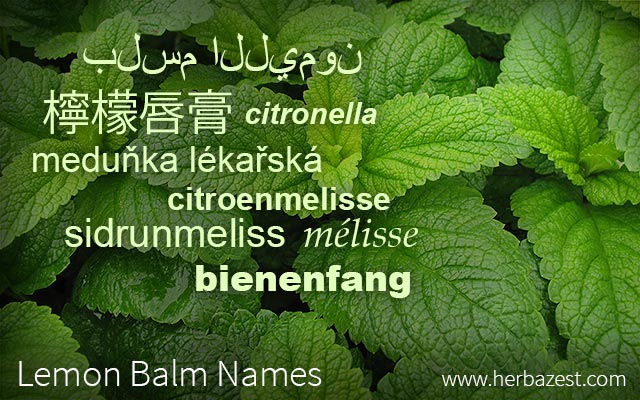Native to northwestern Africa, the Madeira Islands, the Canary Islands, southern Europe, and western Asia, lemon balm is now widely distributed around the world due to its incredible adaptability to different kind of climates and soils, to the point of often being considered a weed.
The oldest known name for lemon balm is melissophyllon, a Greek word meaning 'honey leaf,' later derived into another Greek word, melissa, meaning 'honey bee' and used to name the lemon balm genus. The origin of both words is related to the intense sweet-lemony scent of the leaves and flowers of lemon balm, which are famous for attracting bees and butterflies.
Lemon Balm Names Around the World
People who discover the benefits of Melissa officinalis usually wonders how is called lemon balm in Hindi, a culture with a rich tradition in herbalism, or what names receive lemon balm in Spanish. Being clearly a valuable herb, lemon balm's popularity has crossed cultural and linguistic frontiers, and it has been named in a variety of ways since ancient times.
These are some of the most popular names of lemon balm around the world:
Arabic names: Louiza, merzizou, mufarrehal qhalb, utrajul raihath, warqe habaqe rauhawi
Chinese names: Xiang feng cao, xiang feng hua, xiang feng ye (Mandarin); Heung fung chou (Cantonese)
Czech name: Medunka lékarská
Dutch names: Citroenmelisse, melissa citroen, melisse, pflanzensaft, sitronmelisse
Danish and Norwegian names: Citron melisse, citronmilisse, hjertensfryd, moderurt
English names: Balm, balm mint, bee balm, blue balm, heart's delight, melissa, common balm, cure-all, dropsy plant, English balm, garden balm, honey plant, lemon melissa, mountain balm, sweet balm, sweet Mary
Estonian name: Sidrunmeliss
Finish name: Sitruunamelissa
French names: Baume, citra, citragon, citronnelle, mélisse, herbe au citron, thé de France, valverde boutons de fievre crème
German names: Bienenfang, bienenkraut, bienensaug, citronenmelisse, darmgichtkraut, Englische brennessel, frauenkraut, garten-melisse, gastrovegetalin, herzbrot, herzkraut, herztrost, honigblatt, immenchrut, ivenblatt, limonikraut, lomaherpan, melissa, melisse, melissenblatt, melissengeist, melisse pflanzensaft, nervenkräutel, riechnessel, salatkräutle, Spanischer salbei, wanzenkraut, zahnwehkraut, zitronella, zitronenkraut, zitronenmelisse
Hindi names: Baadranjboyaa, billilotan
Hungarian names: Citromfu, méhfu, mézontófu, orvosi citromfu
Italian names: Citronella, cedronella, erba limona, melissa vera
Korean name: Kyullhyangphul
Latin names: Melissa officinalis, Melissa officinalis L., folia citronellae, folia melissae, citratae, melissae, citronellae, melissae folium, Melissa oleum
Persian names: Badranjboya, taragarbha
Polish name: Melissa lekarska
Portuguese and Brazilian names: Erva-cidreira, melissa
Russian names: Melissa, melissa lekarstvennaja, limonajamjata, matotschnik, roewnik, ptschel'nik, papotschnaja trawa
Slovak name: Citra
Slovenian name: Navadna melisa
Spanish names: Balsamita mayor, citraria, melisa, meliza, toronjil
Swedish names: Citronmeliss, hjärtansfröjd, honungsblomma, melissört, modergräs
Whether lemon balm is spelled in Hindi or in Spanish, what is clear is that it has a great relevance in traditional medicine around of the world. Though often considered a weed by gardeners, lemon balm has long been a favorite of apothecaries and herbalists. Its many names demonstrate how valuable lemon balm's benefits are to different cultures.
Sources
- International Research Journal of Biological Sciences, An Overview of Badranjboya (Melissa officinalis), 2013
- Old Names - New Growth, pp. 158 - 160
- The Desktop Guide to Herbal Medicine, pp. 248 - 249
- World Spice Plants - Economic Usage, Botany, Taxonomy, p. 223




